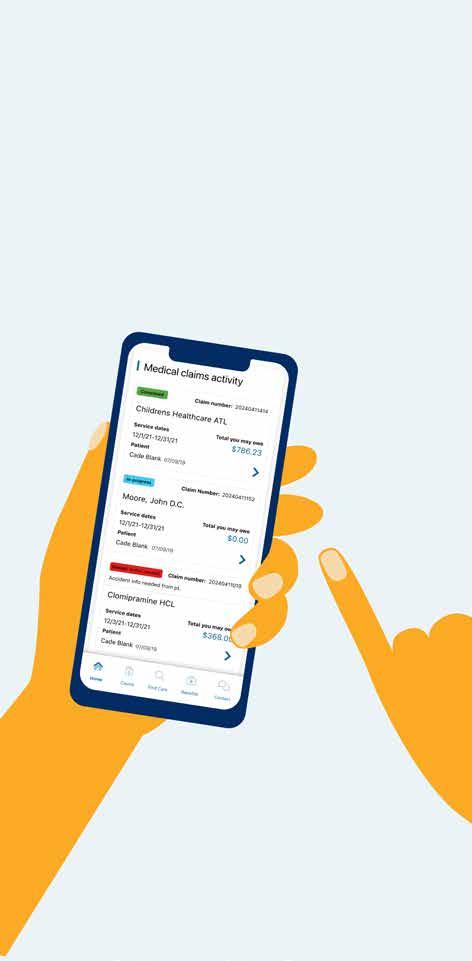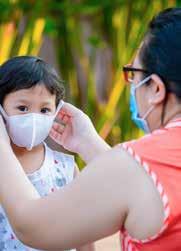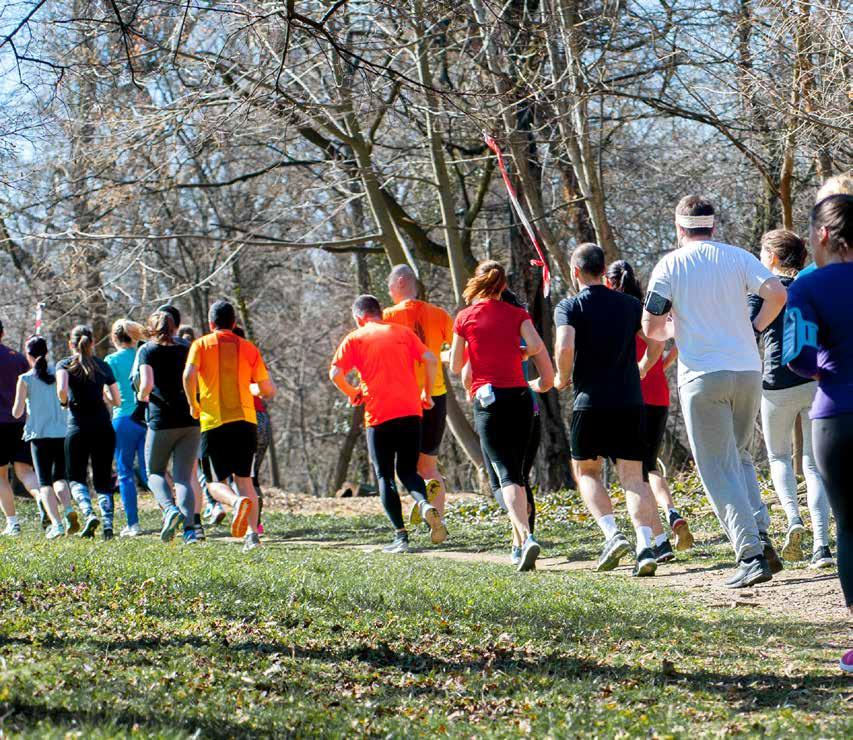Healthy You
Your guide to living well




Spring – 2024
COUCH
PLANNING YOUR
TO 5K
About this magazine
Healthy You is an award-winning magazine featuring health and wellness articles and promoting practical tools that support and encourage healthier choices.
This educational resource for UMR members is published four times a year as part of our member online services and can be viewed, downloaded and shared digitally.
Healthy You is packed with helpful resources and practical recommendations to address the most common health topics, including:
• Building healthy habits
• Preventive care recommendations
• Chronic health conditions
• Exercise tips
• Nutrition and recipes
• Stress and mental health management
• First aid and getting care
• Health literacy
• Spanish-language resources

While using this electronic publication, you may click on a link to other websites. We provide links to other websites that may contain information that may be useful or interesting to you. We do not endorse, and are not responsible for, the content and accuracy of linked websites operated by third parties or for any of your dealings with such third parties. You are solely responsible for your dealings with such third parties, and we encourage you to read the terms of use and privacy policies on such third-party websites.
Available features and benefits are dependent on the products and features included in the plan design. Not all members will have access to all features shown.
Copyright ©2024 United HealthCare Services, Inc. Reproduction in whole or part is not permitted without permission in writing from UMR. All information and links were accurate and functional at the time of publication. However, because this electronic publication contains links to third-party sites, information can change and become unavailable.


2 © 2024 United HealthCare Services, Inc.
CONTENTS
6 Work-life balance for remote workers
If you telecommute, these 6 tips can help you better balance work and personal demands.
9 Antioxidants: Your body’s shield
Learn what antioxidants are and how they work to protect your health.
12 Couch to 5K plan
Get up and running with this popular fitness program.
16 Spring into a clutter-free home
Discover several strategies for shedding your unwanted stuff and getting organized.
20 Navigating sobriety: How to have fun without alcohol
It can be tricky to be a non-drinker in social situations. Here are some ideas that may help.

26 Steer clear: The many dangers of distracted driving
Distracted driving is becoming more common. Find out how to stay safe on the road.
29 The lowdown on Low-T
Learn about the symptoms, causes and treatments for low testosterone, which affects one in four men over 30.
3 © 2024 United HealthCare Services, Inc.
TRACK YOUR CLAIMS 4 UMR ON THE GO APP 5 FIND A PROVIDER 15 WHERE TO GET CARE 24 AIR QUALITY INDEX/ MONTHLY OBSERVANCES 32 THINGS TO DO ON UMR.COM 33 SIMPLE RECIPE 34 EN ESPA Ñ OL 35 Register on umr.com to take advantage of all our online resources for members.
Buried in paperwork?
Track all your claims in one place

Hassle-free access when you need it
Check in at your convenience to see if a claim has been processed and what you might owe. You can search the claim activity for everyone on your plan, view your claims cost summary or submit a new claim.
Check out this FREE resource.
Sign in to your member account on umr.com.
4 © 2024 United HealthCare Services, Inc.
Welcome to a smarter, simpler, faster way to manage your health care benefits, right from the palm of your hand.
UMR on the go!

The UMR app has a smart fresh look, simple navigation, and faster access to your health care benefits information. View your plan details on demand – anytime, anywhere.
With a single tap, you can:
• Access your digital ID card
• See a personalized list of Things to do to stay on top of your health and keep your benefits up to date.

• Look up in-network health care providers
• Find out if there’s a copay for your upcoming appointment
• View your recent medical and dental claims
• Chat, call or message UMR’s member support team
Download the UMR app today!

Simply scan the QR code or visit your app store to get started.
5 © 2024 United HealthCare Services, Inc.

Work-life balance for remote workers
Since 2020, working remotely has become very common. Roughly 35% of workers with jobs that can be done remotely are now working from home full-time.*
With this change, many employees are paying more attention to balancing work, their personal life and everything in between.
Why work-life balance matters
Work-life balance is a term used to describe how people juggle their time between work and personal responsibilities. People who have a good work-life balance can plan for and give adequate time to all aspects of life, including work, friends, family, chores, errands and passions. Having a poor balance between work and personal life can negatively impact an employee’s productivity and happiness. As a result, people often become more stressed and feel less in control of their day-to-day tasks – professionally and personally.

When an employee has a good worklife balance, they’re more likely to be positive and productive, which can result in a better work output.

6 © 2024 United HealthCare Services, Inc.
to a recent
Center survey
* According
Pew Research
Pros and cons of working remotely
Working remotely has upsides and downsides. And depending on what type of person you are, some of the negatives may outweigh the positives; it’s not for everyone. Some employees feel they have more flexibility and freedom during the workday, while others struggle to stay engaged and be heard within their organization.
A market survey conducted by “Great Place to Work” asked 4,200 fulland part-time employees about their employee experience. Employees were asked questions about being valued as an employee, work-life balance, productivity and more. Here are some results:

<50% 63%
I MAKE A DIFFERENCE
Less than half of fully remote employees surveyed indicated that they “make a difference” within their organization, compared to 65% of employees who work in-person.
I HAVE BALANCE
63% of remote workers reported higher levels of work-life balance and psychological and emotional health, compared to 57% of in-person workers.
6 tips to achieve work-life balance
1 Plan and schedule accordingly
The goal for most people would be to have a high level of value at work and a healthy worklife balance.
If you have the choice to work remotely, set a daily or weekly schedule and try your best to stick to it. Having an established schedule will not only keep you on top of your daily tasks, but will also send non-verbal messages to colleagues for when to and when not to communicate with you.
For example, Sarah has a daily block on her calendar between 1-2 p.m. to pick up her child from school. Because she does this every day, her co-workers became aware of this and now do not contact her during those hours unless it’s an emergency.
7 © 2024 United HealthCare Services, Inc.

2 Use resources available to you and visible to others
Many remote jobs use tools, such as Slack and Microsoft Teams, to stay connected. Once you have a daily schedule in place, it’s important to publicize this schedule to others so they are respectful of that time. An easy way to help maintain your focus when working is to change your notification settings for your communication tools so you’re only notified about emails or instant messages during certain times of the day.
3 Use personal tasks to take breaks during the day
One of the biggest perks of working remotely is flexibility. Use personal errands to add breaks while working. Whether it’s a lunchtime run, cooking or just folding laundry, you can split your day into small chunks without overwhelming yourself with work.
4 Establish a daily routine
Treat working remotely just as if you had to go into an office. Often, employees who work remote have more time on their hands because they don’t have to pick out work clothes and commute. But it’s still important to have a routine in the morning, such as showering, making breakfast and planning out your day before diving into work.
5 Dedicate a lunch time
Since you’re working remotely, you don’t have the physical reminders of co-workers or an in-office cafeteria to prompt you to eat during the workday. It’s important to establish a lunchtime for yourself so you can take a break from work, nourish your body and recharge for the afternoon.
6 Cultivate relationships
Connect regularly with your manager and co-workers to make sure your contributions are noticed. Investing in these relationships will not only raise your profile as an employee, but also boost your mental health, which is good for you both personally and professionally.
8 © 2024 United HealthCare Services, Inc.
ANTIOXIDANTS ARE ESSENTIAL FOR THE SURVIVAL OF ALL LIVING THINGS
Antioxidants: Your body’s shield
In the world of health and food, “antioxidants” is a popular buzzword. However, few people fully understand what antioxidants are and what they do for our bodies.
What are antioxidants?



As a normal function, our bodies produce free radicals. Free radicals break down food and are created in response to toxins in our environment, like tobacco smoke and radiation. Our immune cells also use free radicals to fight infections. For these reasons, our bodies need a healthy balance of free radicals.
However, too many free radicals in our bodies can cause damage. That’s where antioxidants come in.
Antioxidants help inhibit the creation of free radicals – which will lead to that healthy balance we need.
Our bodies need balance
When free radicals outnumber antioxidants, it can lead to a state called oxidative stress, which is harmful to our bodies.
ANTIOXIDANTS ARE THERE TO KEEP FREE RADICALS IN CHECK
.
Having too many free radicals in your body is linked to several illnesses, including diabetes, heart disease and cancer.
9 © 2024 United HealthCare Services, Inc.
Normal cell
Free radicals attacking cell
[ ]
Cell with oxidative stress
Arming your body with antioxidants is one way to fight free radicals, but it isn’t the only way.
Reducing exposure to pollutants, exercising, and limiting alcohol and fried foods can all contribute to cutting down on free radicals.
Where are antioxidants found?
Antioxidants can be either natural or artificial. There are four major sources of antioxidants:
1. Your body
Antioxidants are naturally made in your body every day.

3. Vitamins
The major antioxidant vitamins are carotenoids (such as beta-carotene), vitamin C and vitamin E. Several foods contain a high amount of these vitamins.


2. Foods
All living things (plants and animals) have built-in protection against free radicals and oxidative damage. This means antioxidants can be found in any whole food.







4. Supplements
While antioxidant supplements are available, some research suggests the body absorbs antioxidants better when consumed as food versus a supplement.
Focusing on a healthy lifestyle is the best defense.
In general, if you’re eating a balanced diet full of fruits, vegetables and whole foods, you don’t need to worry about getting enough antioxidants.
10 © 2024 United HealthCare Services, Inc.
How can I get more antioxidants?
There are many antioxidant-rich foods and beverages that can be added to your diet. A good rule of thumb is to eat more whole grains, fruits and vegetables. The more colorful your plate, the better!
• Berries (blueberries, raspberries and strawberries)
• Broccoli
• Cantaloupe
• Cherries
• Coffee
• Dark chocolate
• Figs
• Green tea
• Guava
• Leafy greens
• Oranges
• Peaches
• Tomatoes
• Vegetable oils

Enjoying a diet full of vibrant salads or juicy berries is a delicious way to strengthen your body’s defenses while contributing to your longterm health.

For a refreshing antioxidant drink, try making fresh juices from your favorite fruit combinations.

Blueberries are the most powerful antioxidant fruits.
While antioxidants alone serve a specific role, the vitamins they are found in contain other health benefits. Most antioxidant-rich vitamins are also linked to anti-aging and anti-inflammatory properties.
WHAT ARE THE BENEFITS OF ANTIOXIDANTS?
Research on antioxidants and their benefits is mixed.
Since antioxidants protect against the damage caused by free radicals, they are associated with lowering the risk of the negative effects of free radicals, including heart disease and certain types of cancer.
While antioxidants can help fight against these conditions, no study has conclusively proven that antioxidants can prevent them.
As a standalone molecule, there isn’t strong evidence that antioxidants have health benefits beyond their role in shielding the body from free radical damage. However, antioxidants are commonly found in sources like vitamin E and C, iron and zinc, which can strengthen immunity.
11 © 2024 United HealthCare Services, Inc.
On your mark, get set, go ...
A COUCH TO 5K PLAN
BE CAREFUL:
Make sure to warm up and stretch before any exercise –and cool down after.


WEEK 1- You’ll start with an approachable feat: one minute of running at a time. For about 20 minutes, alternate between walking and running for one minute intervals. This can be done three times a week. Other days are dedicated to rest or strength training (core and arm workouts or sports you enjoy).
WEEK 3 - Increase your running intervals to at least two minutes or more. You may feel some resistance at this point; after all, your body is getting used to a whole new routine.
12 © 2024 United HealthCare Services, Inc.
2 3
If you’re one of the (few) people who stuck to your New Year’s resolution to get fit, or you’ve been interested in running but have yet to take the plunge, you may be considering doing a 5K. A 5K stands for 5 kilometers, or three miles. For beginners, the multiple-mile sprint can be daunting. That’s why programs like Couch to 5K exist.
The goal of this program is to guide you from the comfort of your couch to the triumphant finish line of a 5K.
There are several variations of Couch to 5K, but each is a beginner-friendly exercise plan that lasts six to 12 weeks and gradually builds up your endurance.
The idea is to sprinkle running into your routine, slowly transforming you into a confident runner, one jog at a time. These plans can be accessed through a mobile app or found online. Videos and audio are available to easily follow along. Some are free, and others cost a small fee.
What to expect
Below is a sample of a plan and what will happen throughout the program. This is a loose outline of a schedule, but there are many variations available.
Talk with your doctor before significantly increasing your activity level. This is especially important for those with underlying medical conditions. Ask about the amounts and types of activities that may be best for you.
WEEK 4 - You should be running for approximately four minutes at a time, still alternating with walking. Same as week one, you’ll be dedicating two days to other physical activity for the rest of the week (with about two rest days).

WEEK 6 - It will also be important to be running multiple miles. Try two miles at a time. You’ll switch to rest or active rest (yoga, stretching) instead of strength training on the days you aren’t running.
WEEK 5 - You’re getting stronger! Instead of focusing on running at minute intervals, you’ll start to tackle running based on miles – starting with one mile. This is around when you’ll phase out walking as part of your intervals.
4 6
BUILD
CONFIDENCE:
Don’t worry about speed –it’s more important to keep running without stopping.
13 © 2024 United HealthCare Services, Inc.
HALFWAY POINT!

STICK WITH IT:
Try joining a community of other people doing Couch to 5K to stay motivated.
Strength in every step
The benefits of aerobic exercise are seemingly endless. Consistently walking or running can reduce health risks, help you lose weight, increase your mobility and stamina, boost your mood and much more.
Aside from the general benefits of being more active, participating in a 5K comes with its own rewards. Setting a goal and achieving it can create feelings of pride and confidence. Preparing for a 5k is a satisfying way to watch real-time progress, as you surpass physical limitations and cover new distances.
WEEK 8 - Time to dive in – run three miles. This will ensure you’re in tip-top shape for your 5K. Keep focusing on active rest during your off days.
WEEK 7 - You’ll really start to notice a change in your body at this point. Your muscles will be more durable, and your lungs will breathe in faster and deeper. You should be at around two and a half miles of nonstop running.

Run your 5K and relish in all the hard work it took
FINISH LINE!
14 © 2024 United HealthCare Services, Inc.
7


15 © 2024 United HealthCare Services, Inc. Sign in to umr.com Once signed in, select Find a provider Search for a medical provider from your network listing 1 2 3 Finding a doctor or hospital on umr.com
the most of your health care dollars when you use in-network doctors, hospitals, pharmacies, labs and other providers. Searching for and using in-network providers Call us with any questions Find the toll-free phone number for UMR member services on your health plan ID card.
Make
Spring into a clutter-free home
It’s that time of year again – the birds are chirping, the flowers are blooming and you may find the urge to declutter your home. While the thought of spring cleaning may be overwhelming, it doesn’t have to be! Learn how organizing your home can not only have a positive impact on your mental health, but also create more space for the things (and people) you truly value.
Five benefits of a cleaner space
Some advantages of an organized home go far beyond having a clutter-free space.
1. Decreased anxiety and stress levels by creating a calmer environment. Clutter and mess can be tied to negative thoughts and emotions, while a more organized home can produce positive emotions like calmness and an overall sense of well-being.
2. Better focus and productivity with fewer visual distractions. Clutter can limit your brain’s ability to process information.
3. Higher quality sleep.
4. Improved safety (for younger and older members of the household).
5. More control of your environment.

Deciding to declutter is the easy part.
Knowing where to begin is where it can get tricky.




Getting started
Begin by asking yourself a few questions when choosing to keep/get rid of an item:
Have I used this item in the last year?
Can someone else benefit from it?
Does it have sentimental value or bring me joy?
Do I have multiple types of this item?


Does it still fit my current style?
Would I buy it again?
Will I ever get back into this size and will the item still be in fashion?

Is it gently used and worth donating?
Going through your belongings while keeping these questions in mind can help you work through the decluttering process without getting overwhelmed. Remember: Don’t approach decluttering as a massive, overwhelming project. Instead, break it into a series of small tasks.
Give yourself a set time to work through each area without the pressure of getting it all done during that time. It’s OK to return to the project another day.
17 © 2024 United HealthCare Services, Inc.
Decluttering methods
Did you know there’s more than one method to decluttering? If you’re having trouble starting the decluttering process, here are a few popular strategies to consider:
Five-item rule
Instead of focusing on one area at a time, the fiveitem rule involves getting rid of five items per room. This helps to keep clutter to a minimum in all areas of the home. Additionally, this is less stressful since you’re only focusing on five items at a time.


KonMari method
Marie Kondo’s method encourages keeping only things that “spark joy.” Start by tidying up by category – clothes, books, papers or miscellaneous items – and end with sentimental items. This method focuses on being mindful, introspective and forward looking.
30-day minimalist game
Each day of the month tells you how many items to declutter. The first day is one item; the second day is two items; the tenth day is 10 items and so on. By the end of this 30-day challenge, you will have decluttered 496 items from your home.
Four-box method
For this method, you’ll need four boxes labeled with different categories: trash, give away/sell, store and keep/put away. When tackling an area of your home, sort items into the appropriate boxes before moving on to another area.

Get the kids on board
Like adults, children can form emotional attachments to their belongings and can have a hard time parting with them, regardless of whether they still interact with them or if they fit properly. Start by having an open conversation about what they want to keep and why those items are meaningful or useful to them. Understanding each item’s significance can make it easier to guide them through what can be given away if it no longer fits or gets played with.
Additionally, you can frame decluttering as an exciting chance for another child to enjoy their items as much as they once did.



18 © 2024 United HealthCare Services, Inc.
trash give away or sell keep/put away store give away
Selling vs. donating
Another common roadblock to decluttering is deciding what to do with the items you no longer need or want.
Make a little money
You may consider listing your quality furniture, electronics or clothing on eBay, Craigslist, Facebook Marketplace or Freecycle.
Sell for cheap
Or you can have a yard sale to make extra money. If you have the space to store your items for a while, check to see if there’s a community yard sale scheduled for your neighborhood.

Donate to a good cause
For items in good condition that you wish to donate, consider whether a friend might want them. If not, seek out these organizations:
Books
• Libraries
• Better World Books
• Little Free Library
Electronics
• Computer4Vets
Medical Supplies
• MedShare
Furniture
• Habitat for Humanity
• 1-800-GOT-JUNK
• College Hunks
Hauling Junk
Clothing
• Dress for Success
• Jail to Jobs
• Soles4Souls
Other charitable organizations:
Goodwill, The Salvation Army and St. Vincent de Paul Society
Digitize your memories
Another challenge can be determining what to do with sentimental paper documents, VHS tapes, photos or DVDs.

For photos and paper documents, you can add them to the cloud (Google Cloud or Apple iCloud library) or scan and upload them to your computer or an external hard drive.
For VHS tapes and DVDs, you can purchase a VCR-to-USB adapter or RCA USB adapter to connect your VCR to your computer and upload videos to the cloud or an external hard drive. There are also companies that will do this for you for a fee.






Declutter your way to a fresh start this spring, one manageable step at a time!
P. S. Don’t forget about the garage, the attic and the basement!
19 © 2024 United HealthCare Services, Inc. 19
Navigating sobriety: How to have fun without alcohol


April is Alcohol Awareness Month
So it’s a good time for people to evaluate their relationship with alcohol. A growing number of people are choosing to not drink these days. The reasons for doing this may be health related, financial or just a personal decision.
Embrace change
Here are some helpful ways to choose an alternative to alcohol, and some strategies for negotiating social situations where drinking is present – or even expected.
Navigating social situations
Most of us have been in social settings where drinking is the norm, including wedding receptions, family gatherings and holiday parties. There are ways to choose something other than alcohol and still feel part of the fun.

Order a cranberry juice with lime or a seltzer water with lemon.

Order a nonalcoholic beer, wine or spirit. The options have increased widely over the past few years.
Choosing mocktails

Ask for a soda or water with lemon or lime.

Focus on conversation instead of drinks.

Hold onto your appetizer plate a little longer to have something in your hands other than a glass.
Mocktails have become very popular for many who choose to avoid alcohol. In the past, they’ve been limited to sugary drinks for kids, like a Shirley Temple, but have evolved into more adult options.
Most mocktails come in the same glass as an alcoholic beverage, so you won’t look out of place drinking them. And many mocktails taste just as good as an alcoholic drink, with more complex flavors. If you’re hosting a party, mocktails can be a fun and creative addition to the drink menu.

Try this sparkling tropical mocktail recipe
INGREDIENTS:
• 3/4 cup pineapple juice
• 1/2 cup mango juice
• 1/4 cup fresh lime juice
• 1 cup (8 ounces) ginger beer
• Pineapple wedges, for garnish
• Mango slices, for garnish
DIRECTIONS:
In a cocktail shaker filled with ice, combine the pineapple, mango and lime juices. Shake vigorously.
Strain into ice-filled highball glasses. Top each with some ginger beer. Garnish with pineapple wedges and mango slices and serve immediately.
Yield: 4 servings
21 © 2024 United HealthCare Services, Inc.

Offer

Hosting a party?
Many of us host parties throughout the year. If you’re serving alcohol, it’s thoughtful to offer non-alcoholic alternatives for your guests.
Here are some ideas:
Provide iced or hot coffee and tea with special creamer or add-ins.
Create a station with a variety of fruit juices, sodas and sparkling waters.
Offer garnishes like strawberries, limes and orange slices or herbs like mint or thyme. Use your best barware. Your guests will feel special and their drink will look high class.

Feeling peer pressure to drink?
Sometimes we can find ourselves in a situation where someone will question why we aren’t drinking. It might help to have a few responses prepared that feel right for you. Remember, more people are choosing not to drink, so you are not alone.
I’m the designated driver.
I feel better when I don’t drink. My current medication doesn’t mix well with alcohol.
I don’t drink.
I’m taking a break.
I don’t drink because of my health.
© 2024 United HealthCare Services, Inc.
fresh fruit that can be used in mocktail recipes that you provide.
Replacing the habit of drinking
If you are choosing to not drink and not go to bars or clubs, you may find yourself thinking, “What do I do now?”
Here are some options:
- Pick up a new hobby or restart an old one.
- Try exercise like walking or yoga.
- Join a local club sport team or take a class.
- Do a Google search for local non-alcoholic group activities.
Offer options for the meeting place
Find a neutral “third space,” like a park, bookstore or church, which are usually alcohol free.
- Dry bars offer games like pool and darts, as well as the atmosphere of a bar, but no alcohol.
- Retro arcades are becoming more common and feature video games and pinball from the ’80s and ’90s. Many of these arcades are alcohol free.
- If you like attending events or concerts, find one that’s happening at a coffee shop or community center.
The benefits of not drinking
There are numerous benefits to limiting or eliminating alcohol use, including:
- Saving money
- Creating time for other interests
- Avoiding hangovers
- Feeling more energized
Whether you are permanently quitting drinking, cutting back or just taking a break, you don’t have to give up having fun or worry about feeling left out.



23 © 2024 United HealthCare Services, Inc.
Your true friends will support you.
Bring a deck of cards and offer to teach the gang how to play Euchre or poker.
Help with the food/serving/clean up.
Know where to go when someone is sick or in a crisis situation.




Where you go for medical services can make a big difference in how much you pay and how long you wait to see a health care provider. Explore the following information to help you decide the appropriate setting for your care.
What you need to do:
Locate your member ID card
Find a provider
On your member ID card, you’ll find:
• Your PPO network
• Contact number
• Pharmacy contact, if applicable You can also visit our website at umr.com.
Go to the CDC for the latest information on COVID-19, including vaccines, cases and data, how to protect yourself and what to do if you are sick.
Determine the severity of the symptoms and choose the provider that works for you
If you are severely ill and/or it’s an emergency, call 911.
24 © 2024 United HealthCare Services, Inc.
2
1
3
COLD, FLU OR ALLERGIES
RETAIL CLINIC
Retail clinics, sometimes called convenience care clinics, are located in retail stores, supermarkets and pharmacies. You can find over-the-counter medications, and you can talk to your pharmacist for help.
TIMES TO GO:
• Vaccinations or screenings
• Sinus infections
• Minor sprains, burns or rashes
• Headaches or sore throats
Expect to wait 15 minutes or less
Average cost $50-$100 (per service for non-employer sponsored facilities)
MILD ASTHMA ATTACK
URGENT CARE
Urgent care centers, sometimes called walk-in clinics, are often open in the evenings and on weekends.
TIMES TO GO:
• Sprains and strains
• Sore throats
• Minor broken bones or cuts
• Minor burns
• Minor infections or rashes
• Earaches
Expect to wait 20-30 minutes
Average cost $150-$200 (for non-employer sponsored facilities)
NOT FEELING WELL
DOCTOR’S OFFICE
(NOT URGENT)
Seeing your doctor is important. Your doctor knows your medical history and any ongoing health conditions.
TIMES TO GO:
• Preventive services and vaccinations
• Medical problems or symptoms that are not an immediate, serious threat to your health or life
Expect to wait 1 day to 1 week or more for an appointment
Average cost $100-$150
SUDDEN HEALTH CHANGES
EMERGENCY ROOM
Visit the ER only if you are badly hurt. If you are not seriously ill or hurt, you could wait hours, and your health plan may not cover non-emergency ER visits.
TIMES TO GO:
• Sudden weakness, trouble talking or blurred vision
• Large open wounds
• Difficulty breathing
• Severe head injury
• Heavy bleeding
• Spinal injuries
• Chest pain
• Major burns
• Major broken bones
Expect to wait 3-12 hours (for non-critical cases)
Average cost $1,200-$1,500
25 © 2024 United HealthCare Services, Inc. Costs may vary based on your plan. Costs shown represent national averages.




The National Highway Traffic Safety Administration (NHTSA) has named April as Distracted Driving Awareness Month to bring attention to the very dangerous habit of using your time behind the wheel for things other than the No. 1 goal: safe driving.


Their national campaign called U Drive. U Text. U Pay. has called upon law enforcement and the general public to help enforce the importance of resisting the urge to text and drive. The campaign reminds drivers of the deadly dangers, legal consequences and fines of texting and other forms of messaging behind the wheel. Forty-eight states, as well as Washington, D.C., Puerto Rico, Guam, the Northern Mariana Islands and the Virgin Islands, have passed laws making it illegal to text while driving.

U Drive. U Text. U Pay.

Steer clear:
The many dangers of distracted driving
drinking and even applying makeup have been the causes of thousands of car crashes on our roadways, resulting in numerous injuries and lives lost. Within the past decade, distracted driving has become more and more fatal due to the common use of cell phones behind the wheel – talking, using social media and
Of all the distractions, texting is considered the most dangerous because it involves visual, manual and cognitive distraction.
• According to the American Automobile Association (better known as AAA), distracted driving kills an average of nine people and injures more than 1,000 every day in the U.S.
• AAA says research shows that taking your eyes off the road for just two seconds doubles your chance of getting into a crash, which could result in injuries or even death.
• The odds are even higher when using a smartphone while driving. They also say five seconds of reading an email is like driving the entire length of a football field blindfolded.
*According to The National Highway Traffic Safety Administration
3,522 Lives lost in crashes involving distracted drivers in 2021*

27 © 2024 United HealthCare Services, Inc.
The NHTSA and AAA offer simple advice to help keep drivers, passengers and pedestrians safe:
• Appoint a passenger as your “designated texter.”
• If it’s urgent to send or respond to a text, pull over and stop in a safe location to do so.
• Don’t scroll through apps while behind the wheel.
• If you know you’re not going to be able to resist the urge to use your phone, put it in the back seat, glove compartment or even the trunk while driving.
• If using a navigation app, program your destination before driving.

If you’re a passenger, speak up if your driver is distracted.
communication while connected to your Bluetooth.
Most states have banned the use of handheld devices Almost all cars now come with the ability to use your phone hands free. Make sure to take
And of course, there are other forms of distraction, too:
If you’re driving a car that you’re not used to, take some time to become familiar with the controls – especially
Make sure the kids are settled and properly restrained
If you’re angry, tired or otherwise distressed, take some
8%
Fatal crashes that involved distracted drivers in 2021*
Remember, the life you save could be your own.
32,000 Approximate number of people who died in distracted driving crashes from 2012-2021*
Take the pledge
Take action and pledge to stop driving while distracted. Commit to not placing yourself, your passengers, other drivers and pedestrians in harm’s way. And speak up if you’re riding with a distracted driver.
If you have children, strive to be the role model who puts the phone down while driving. They’re watching what you do!
28 © 2024 United HealthCare Services, Inc.
The lowdown on Low Testosterone

Low testosterone, also known as male hypogonadism or “Low T,” affects in the U.S.

Testosterone is a hormone made in the testes and controlled by glands in the brain, such as the hypothalamus and pituitary. It’s the main sex hormone in men, important for development and maintenance for a man’s sex drive, as well as his physical appearance.
Age 70
Age 80
• Maintain sex drive and erections
Control hair growth and body fat distribution
• Strengthen bones and muscles
29 © 2024 United HealthCare Services, Inc.
It’s normal for men to experience lower-than-average testosterone levels beginning around ages 30-40.
This drop in levels is also sometimes referred to as “male menopause. ”
The decrease is not always alarming, but rather an accepted side effect of approaching middle age.
Other causes or factors
Although Low T is a natural occurrence as men age, there are factors that could increase the instances and likelihood of Low T. These may include:
• Injury or cancer in the testicles
• Side effects of medicines (like chemotherapy)
• Hormone production issues from glands in the brain
• Obesity
• Low thyroid function
• Infections
• Disorders or chronic diseases
• High blood pressure
• Diabetes
If you’re experiencing any of these symptoms, talk with your health care provider. They can perform a blood test to check your testosterone levels and will most likely investigate other causes of these symptoms.
Treatment


Testosterone replacement therapy (TRT) is a hormone therapy that can help replenish testosterone levels in your body. The medicine used is a man-made testosterone and can be prescribed as a pill, gel, patch, injection or implant.
TRT has shown to improve or relieve symptoms in some men and may also help keep bones and muscles strong.
Risks and side effects
There are risks and side effects to this treatment that may include:
• Infertility
• Enlarged prostate
• Blood clots
• Sleep disorders
• Cardiovascular problems
• Cholesterol issues
Improvements


Men using TRT should notice a change in symptoms within three months. If no improvements are noticed, chances are TRT is not working effectively and will probably be discontinued. Men starting TRT must also see their provider regularly for checkups.
If you’re experiencing symptoms of Low T and are curious or concerned, talk to your provider.
© 2024 United HealthCare Services, Inc.


31
AQI: Your guide to breathing easy
As temperatures warm up and you spend more time outside, it’s important to pay attention to the Air Quality Index (AQI), especially if you have a condition that makes you more vulnerable to poor air quality. High-risk groups include children under 18, the elderly, people with chronic heart or lung disease (including asthma), pregnant people and people with diabetes.
Air quality is satisfactory.
Air pollution poses little to no risk.
Air quality is acceptable.
However, there may be a risk for some people, particularly those who are unusually sensitive to air pollution.
What causes changes in the index?
• Strong UV radiation from the sun and warm air temperatures. These cause high levels of ozone, creating higher emissions from motor vehicles, industry, paints, solvents and gasoline fumes.
• Smoke from wildfires. Wildfire smoke carries a variety of pollutants, including carbon monoxide (CO), nitrogen oxides and particle pollution – a mix of very tiny solid and liquid particles suspended in air. Particle pollution can cause asthma attacks, heart attacks and strokes. Inhaling CO reduces oxygen delivery to the body’s organs and tissues and can lead to headaches, nausea, dizziness and, in high concentrations, premature death.*
* According to the American Lung Association
Air quality is unhealthy. Members of sensitive groups may experience health effects. The general public is less likely to be affected.
Air quality is unhealthy. Some members of the general public may experience health effects. Members of sensitive groups may experience more serious health effects
On days when the AQI is orange, red, purple or maroon:
• Reduce the time you spend outdoors to under 30 minutes.
• Reduce the intensity of outdoor activity. Schedule outdoor activity when the AQI is lower.
• Wear a mask. If you must go outdoors, consider wearing a wellfitted N95 or KN95 mask.
• Keep the windows and doors closed. Running the air conditioning on the recirculate setting will keep the air indoors healthier.
• Use an air purifier or a portable HEPA air cleaner in the rooms where you spend the most time.
• Stay hydrated if you’re exposed to wildfire smoke.
You can find the Air Quality Index (AQI) in most weather apps.
Air quality is very unhealthy.
Health alert: The risk of health effects is increased for everyone.
Air quality is very unhealthy.
Health warning of emergency conditions; everyone is more likely to be affected.
Monthly health observances for spring:
APRIL
Alcohol awareness
Distracted driving
Air quality
MAY
Asthma and allergies
Skin cancer
Women’s health
Physical fitness and sports
JUNE
Cancer survivors
Men’s health
Personal safety
32 © 2024 United HealthCare Services, Inc.
The Daily AQI color chart shows levels of concern and values of air quality.
for sensative groups
51-100 101-150 151-200 201-300 301+
0-50 Good Moderate Unhealthy Hazardous Unhealthy
Very Unhealthy
“Things to do” on umr.com
Sign in to umr.com to see a personalized to-do list that highlights the steps YOU need to take to stay on top of your health and keep your benefits up to date. Personalization is based on your company’s health benefits plan and the programs you are eligible for.

•
33 © 2024 United HealthCare Services, Inc.
health
Your
care manager at your fingertips
Needs attention Marked complete. No more action needed “Things to do” may prompt you to:
Review and complete health actions
Provide/verify your email address
Provide other insurance information
Update security questions
•
•
•
•
Review new claims
Be promptly alerted to any denied claims
Provide accident details
Go paperless
Get to know UMR
Take your clinical health risk assessment (CHRA) ! Visit umr.com today to take advantage of this time-saving feature!
•
•
•
•
•
Mango berry rotini salad
Makes 4 servings

This easy, colorful twist on pasta salad is full of antioxidant -rich ingredients, including berries, mango and spinach.
SALAD INGREDIENTS
• 1 cup (4 oz) whole-wheat rotini pasta, uncooked
• 1 ripe mango
• 1 cup raspberries
• 1 cup blueberries
• 2 cups baby spinach, fresh
• 1/2 cup reduced-fat feta cheese
DIRECTIONS
VINAIGRETTE INGREDIENTS
• 3 tablespoons extra virgin olive oil
• 2 tablespoons raspberry vinegar
• 1 teaspoon sugar
• 1 teaspoon poppy seeds
• 1/4 teaspoon salt
1. In a small bowl, whisk vinaigrette ingredients; set aside.
2. Boil water and cook rotini according to package instructions. Drain cooked rotini and rinse in cool water.
3. While rotini is cooking, cut mango into chunks, removing peel and pit.
4. Place salad ingredients in a large bowl; drizzle with vinaigrette. Toss gently.

For more healthy recipes, visit MyPlate Kitchen.
Recipe/photo courtesy of U.S. Department of Agriculture.
34 © 2024 United HealthCare Services, Inc.
EN ESPAÑOL
Recursos para ayudarle a vivir una vida más saludable

Visite umr.com y seleccione Health Education Library (Biblioteca de Educación en Salud) para obtener información confiable.
Para nuestros miembros de UMR que hablan español, los Institutos Nacionales de Salud (NIH por sus siglas en inglés) es un gran recurso para obtener información sobre temas de salud, desde alergias hasta Zika. Cada mes, el boletín electrónico destaca nuevos recursos para aquellos que hablan español, y sus amigos y familiares. Puede visitar el portal y suscribirse al boletín en https://salud.nih.gov/


Le ayudamos a mantenerse informado sobre el coronavirus (COVID-19)
35 © 2024 United HealthCare Services, Inc.

ABOUT US
UMR is a third-party administrator (TPA), hired by your employer to help ensure your claims are administered correctly, so your health care costs can be kept to a minimum and you can focus on your health and well-being.
UMR is not an insurance company. Your employer pays the portion of your health care costs not paid by you.
UMR is a UnitedHealthcare company. ©2024 United HealthCare Services, Inc.





























































































